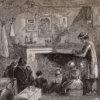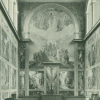
Barbara Leckie, “Prince Albert’s Exhibition Model Dwellings”
This paper discusses Prince Albert’s Exhibition Model Dwellings built just off the grounds of the Great Exhibition in 1851. These model dwellings, designed by the architect Henry Roberts, contributed to growing efforts to place the mid-century crisis in housing of the poor at the forefront of public attention. They also made vivid the intersection of print culture and the built environment in three ways. First, they were a response to decades of print exposés of existing housing of the poor. Second, Roberts wrote a pamphlet, a how-to guide of sorts, on the Exhibition Model Dwellings as well as a book on model dwellings in general, The Dwellings of the Labouring Classes, that went into four editions. Finally, the Exhibition Model Dwellings were the topic of many contemporary print commentaries. These latter print commentaries will be the focus of this article. I want both to return the Exhibition Model Dwellings to the prominence they carried in the mid-Victorian period and to explore their contribution to the period’s conflicted response to the crisis in existing housing of the poor with respect to transparency, health, subject formation, and national identity.

Margaretta S. Frederick, “On Frederic Shields’ Chapel of the Ascension, 1887-1910”
On 26 February 1911, the Pre-Raphaelite artist Frederic Shields (born 1833) died, having spent the last twenty years of his life devoted to the decoration of the Chapel of the Ascension in Bayswater, London. Conceived of in 1887, completed in 1910, bombed in 1944 during the Blitz of World War II and demolished in 1969, the Chapel represents changing Victorian precepts of religion and faith as well as attitudes towards public art and decoration on the eve of the modern age. Designed by the architect and aesthete Herbert Horne (1864-¬1916) and modeled on thirteenth-century northern Italian church architecture, the chapel design was a reflection of the British rediscovery of the Italian Renaissance during the Victorian period. Shields’ use of the marouflage technique, mimicking continental fresco schemes, reflects a national desire to raise public British art to a level of “high art,” which would ensure it a place in the art historical canon.
